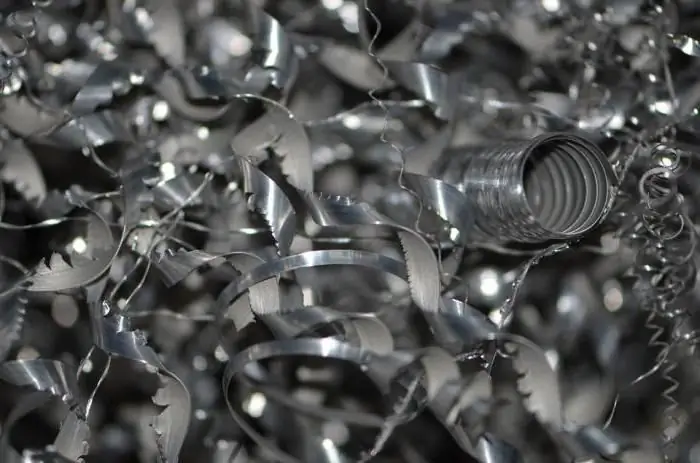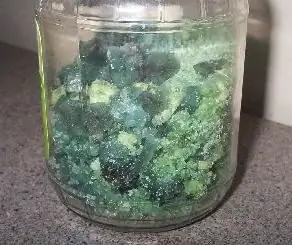2025 Author: Howard Calhoun | [email protected]. Last modified: 2025-01-24 13:10:33
Ferrous sulfate is a chemical compound that is extremely common in nature and widely used in various fields of economic activity. There are divalent and trivalent modifications of this substance. The first variety, also called ferrous sulfate, is an inorganic binary non-volatile compound having the formula FeSO4. Externally, this chemical compound is a transparent crystal hydrates of light greenish-blue color, having a high degree of hygroscopicity and solubility in an aqueous medium. In a vacuum, FeSO4 decomposes with high intensity, complete decomposition occurs at a temperature of about 700°C.

Ferrous sulfate is a widely used reagent that crystallizes from solutions at room temperature in the form of FeSO4∙7H2O heptahydrate, which is a pale blue substance. When stored for a long time, it erodes, turning into a white powdery substance,and in the open air gradually turns yellow due to oxidative processes. The weathering of ferrous sulfate is explained by the fact that in its structure there is one molecule of outer sphere water, which easily leaves the crystal lattice.
Trivalent anhydrous iron sulfate is a light yellow, paramagnetic, extremely hygroscopic monoclinic crystal substance. Capable of forming orthorhombic and hexagonal structural modifications. Trivalent iron sulfate crystallizes well from various solutions in the form of various hydrated compounds containing up to ten water molecules. When slowly heated, it turns into an anhydrous s alt, which decomposes well into hematite and sulfuric anhydrite at a temperature of about 650 ° C. Like many other s alts of triply charged cations, ferrous sulfate forms alums that crystallize in the form of pale purple octahedrons. This substance is a good reducing agent for the Ag+ ion, which has strong oxidizing properties. Ferric sulfate, hydrolyzed by boiling the solution in which it is contained, occurs in nature predominantly in jarosite (mineral).

In industry, this substance is obtained mainly as a by-product in metalworking enterprises from various pickling solutions used to remove scale from steel products. Also, this substance can be isolated by calcining pyrites or marcasite with NaCl in air. Another way to synthesize itis the heating of iron oxide in s alts of sulfuric acid. In laboratory practice, this compound is isolated from Fe(OH)2.
It is of considerable curiosity that iron sulfate was discovered on Mars in 2009 by the Spirit spacecraft, from which scientists concluded that strong oxidative processes are occurring on the surface of the planet. Due to the very low density of this substance, the rover is so deeply bogged down in its deposits that it even touched the deep layers of the Martian soil with part of the hull.

On Earth, iron sulfate, due to its ability to hydrolyze, is used along with aluminum alum as a flocculant in the process of drinking water purification. Forming hydroxide flakes, this chemical compound adsorbs many harmful impurities. Also, this substance has found wide application in medicine, where it is used as a therapeutic and prophylactic agent for iron deficiency anemia.
In the agricultural industry, iron sulfate is used for chemical soil reclamation, pest control of cultivated plants, destruction of mosses, lichens, weeds and spores of parasitic fungi. In horticulture, ferrous sulfate is used to feed fruit trees as a catalyst for the formation of chlorophyll. The most sensitive to the lack of this substance are apple, pear, plum and peach.
Industrial Ferrous sulfate is widely used in the textile industry, where it is an important ingredient in inks and various mineral dyes. Alsothis substance is a good wood preservative. Some so-called waste solutions of iron sulfate are processed into insulating materials such as ferron and ferrigypsum, which are a mixture of hydrates of this compound with various fillers.
Recommended:
Non-ferrous metals: features and areas of use. Non-ferrous metal processing

Non-ferrous metals and their alloys are widely used in industry. They are used to make machinery, working tools, construction materials and materials. They are used even in art, for example, for the construction of monuments and sculptures. What are non-ferrous metals? What features do they have? Let's find out
Non-ferrous, precious and ferrous types of metals and their characteristics

Metals are a large group of simple elements with characteristic features such as high thermal and electrical conductivity, positive temperature coefficient and more. To properly classify and understand what's what, you need to deal with all the nuances. Let's try with you to consider such basic types of metals as ferrous, non-ferrous, precious, as well as alloys. This is quite an extensive and complex topic, but we will try to put everything on the shelves
Tungsten: application, properties and chemical characteristics

Mother nature has enriched mankind with useful chemical elements. Some of them are hidden in its bowels and are contained in relatively small quantities, but their significance is very significant. One of these is tungsten. Its use is due to the special properties
Terephthalic acid: chemical properties, production and applications

Terephthalic acid is a colorless pure crystalline powder obtained during the reaction of liquid-phase oxidation of para-xylene in the presence of cob alt s alts acting as catalysts. The interaction of this substance with various alcohols leads to the formation of chemical compounds of the ether group. Dimethyl terephthalate has the greatest practical application
"Cyclone B": history, features, chemical and physical properties

"Zyklon B": a detailed description of the pesticide poison. It tells in detail about the effect on the human body, the use of poison by the Nazis

